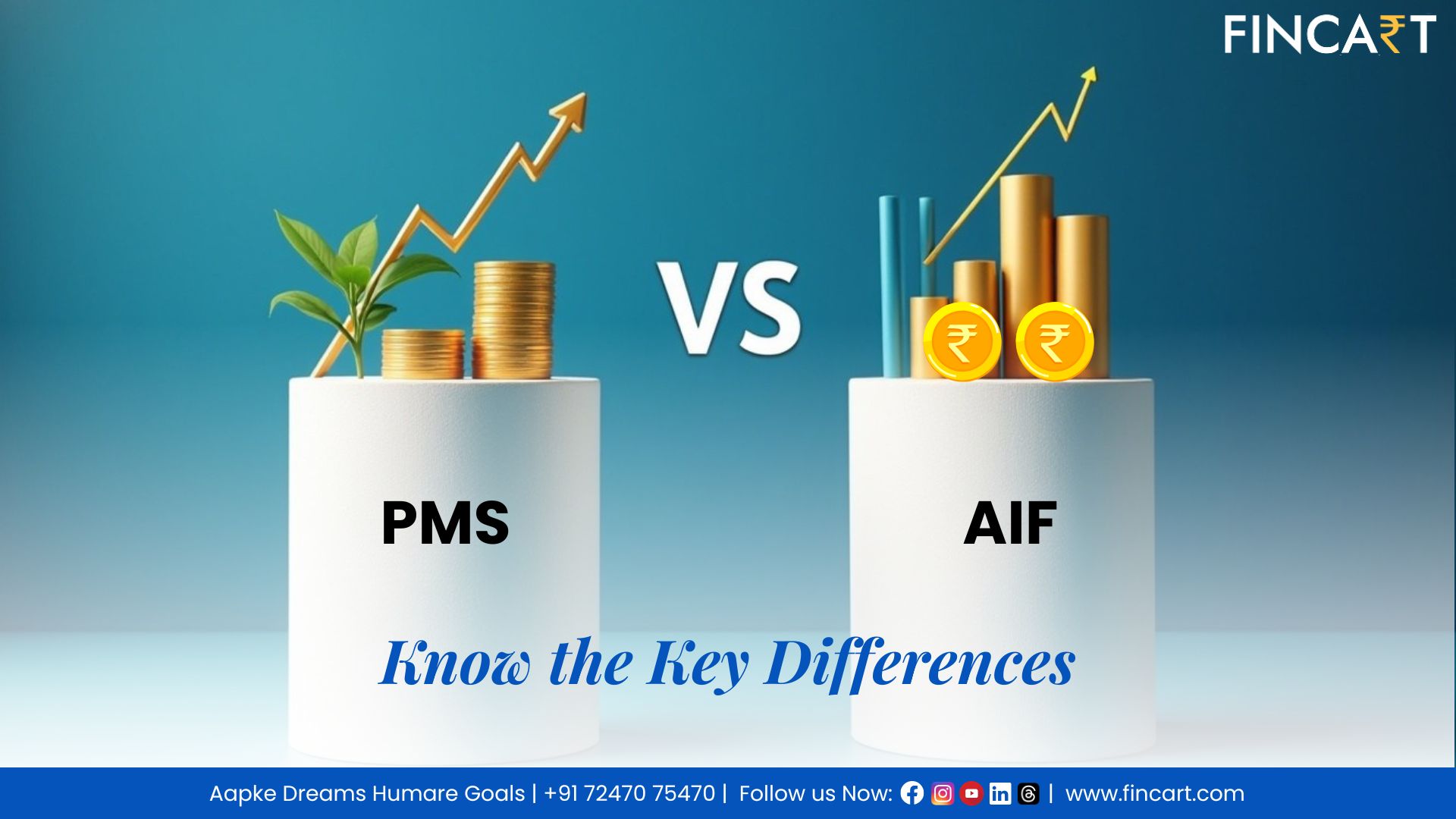When we think about investments, most of us picture the standard vehicles such as stocks, mutual funds, bonds, fixed deposits. And for most people, these classics do the job. But for those who have a larger corpus to invest, there are some interesting, more advanced options out there. High-net-worth individuals often use these vehicles to diversify, take more risks, and aim for higher returns.
Two such options that have picked up steam over past few years are portfolio management services and Alternative Investment Funds. They’re more sophisticated, more complex, and not suitable for retail investors. They are both professionally managed solutions which employ strategies that normal investments (mutual funds) typically cannot. However, there are significant differences between pms vs aif. If you’ve got a sizable investible surplus to deploy, this blog should give you an idea about what PMS and AIFs are, how they differ, and which option might fit you best.
What Are Portfolio Management Services?
PMS is a SEBI-regulated financial service where professional portfolio managers create and manage a personalised basket of investments on your behalf. The PMS provider takes into account your financial goals, risk appetite, and investment horizon to ensure your portfolio maximises returns, minimises risks, and helps you reach your long-term goals on time.
According to SEBI, a minimum of Rs. 50 lakh must be maintained to invest in a PMS. Due to this high entry barrier, only investors with adequate financial capacity who can take on high risks can opt for these services.
How Does a PMS Investment Work?
To understand portfolio management services better, let’s first compare them with mutual funds. When you invest through a mutual fund, your money is pooled together with thousands of other investors. Everyone in that scheme has the same portfolio, and every buy or sell decision the fund manager makes affects all investors equally.
With PMS, it works very differently. First, your money is not pooled with others; in fact, all securities within the portfolio are held in your own demat account. Second, PMS is not as tightly regulated by SEBI as the mutual fund industry. This also gives PMS a lot more flexibility compared to mutual funds and the portfolio manager can follow unconventional strategies that a fund manager simply cannot. But this also comes with higher risks. For example, if a portfolio manager takes concentrated bets, a single stock going wrong can drag down your entire portfolio. That’s why pms services are better suited for investors who have a longer investment horizon and the risk tolerance to handle short-term fluctuations.
PMS Costs
In mutual funds, the main cost is the expense ratio, but for PMS, there’s a bit more complex fee structure. PMS providers can charge fees in two ways:
- Fixed Fee: A flat fee charged as a percentage of the assets under management.
- Performance Fee: Sometimes also called profit-sharing fees, these expenses are applicable when the portfolio returns cross a specific level of return. Over that threshold, your manager can take a percentage of the extra profit.
Different PMS have different fee structures, so be thorough before signing up. While there may not be any lock-in period involved, your manager can impose an exit load if you decide to withdraw prematurely. Other than these fees, some minor charges, such as brokerage, audit charges, and demat account maintenance costs, also apply.
Types of PMS
There are broadly three types of pms investment available:
1. Discretionary PMS
In this type of PMS, the client gives the portfolio manager full authority to make investment decisions on their behalf. The manager can act at their own discretion and buy or sell securities without seeking your approval for each transaction. Discretionary PMS is often chosen by investors who have limited time or knowledge to manage their portfolio on their own, and trust the manager to make well-researched decisions that align with their goals.
An advantage of discretionary PMS is that the manager can move quickly to pounce on opportunities without delay.
2. Non-Discretionary PMS
This type of PMS is suitable for those investors who want to retain some control over their investments, because the portfolio manager cannot execute any trades without first seeking your approval. The manager will recommend buying or selling certain securities based on their research, but the final decision always rests in your hands
While this model allows you to have a say in your investments, it can also lead to delays in the execution of trades. So, unless you are quick to respond to your manager’s suggestions, it can be hard to seize timely opportunities.
3. Advisory PMS
As the name suggests, in this type of PMS, the manager’s role is limited to only providing investment advice and recommendations. They do the hard work by analysing market trends and suggest what you should buy or sell, but they do not execute any trades on your behalf. Therefore, all management related responsibilities lie with you. While advisory PMS gives investors maximum control, it is ideal only for those who are financially knowledgeable and are keen on managing their money themselves.
What Are Alternative Investment Funds?
Alternative investment funds are pooled investment vehicles where managers invest in a much larger range of asset classes and strategies not covered by mutual funds, such as private equity and venture capital. A minimum of Rs. 1 crore is needed to invest in most AIFs. So if PMS is designed for HNIs, then AIFs are essentially meant for ultra-high-net-worth investors who are comfortable taking on significantly higher risk and dealing with complex assets. This is one of the primary pms vs aif differences.
Most AIFs are close-ended, and the maximum number of investors cannot exceed 1000. This structure also comes with a lock-in period, which depends on the category but is generally much longer than anything you’d see in mutual funds. The fee structure of AIFs is also much more complex, with managers charging fixed and performance-based fees, amongst others.
How Do AIFs Work?
AIF are indeed a bit like mutual funds as they also pool money from multiple investors into a single fund. However, the similarity ends there. AIFs operate in a completely different space. Their regulations are a lot less restrictive compared to mutual funds, as AIFs are allowed to invest in assets and strategies, such as private equity, venture capital, hedge-fund strategies, and complex derivatives that mutual funds simply cannot even touch.
The main reason why SEBI has such strict regulations for the mutual fund industry in the first place is that mutual funds experience heavy participation from retail investors, so there needs to be tight rules around diversification, liquidity, and risk exposure to protect investors. With AIFs, that changes because they are designed only for sophisticated investors who are assumed to understand the higher risks and complexity involved with these vehicles.
Types of AIFs
According to SEBI, there are three broad categories of alternative investment funds:
Category I AIFs
These funds invest in high-growth potential sectors such as startups, SMEs, and infrastructure. Examples include:
- Angel Funds: In these funds, accredited investors pool money to back early-stage start-ups with high growth potential.
- Infrastructure Funds: These funds focus on long-term infrastructure projects such as highways, ports, airports, etc.
- Venture Capital Funds: These funds are like angel funds, but instead of absolute beginner stages, investments are made once the business has gained some traction.
- Social Venture Funds: Here, the aim of investing is not just to generate high returns, but to do so by investing in companies that create a positive impact on society.
Category II AIFs
As per SEBI, Category II AIFs include all funds that do not fall under Category I or Category III, and do not take any more leverage than needed for daily operations. All Category II AIFs are closed-ended. Some examples are:
- Private Equity Funds: Some private businesses find it hard to raise capital through banks or markets. Private equity funds provide them the required long-term capital in exchange for a significant ownership stake. This helps the unlisted companies grow, and after a number of years, the fund eventually exits at a profit.
- Debt Funds: Similarly, companies that can’t easily raise money through standard loans go to debt-focused AIFs for funding. Because such companies are early-stage borrowers, the credit risk for investors is higher, but so are the potential rewards.
- Real Estate Funds: As the name suggests, these funds invest in commercial and residential real estate projects for rental income. Their scale is much smaller compared to REITs, but they enjoy comparatively more flexibility in terms of where and how they can invest.
Category III AIFs
This category is easily considered to be the most flexible, as managers are allowed to employ complex investment strategies such as leverage, short-selling, derivatives, arbitrage, and long-short trading. Category III AIFs can be open or closed-ended, and their sophisticated strategies make them the most aggressive category of AIFs. Most AIFs in India belong to this category. Examples include:
- Hedge Funds: These are perhaps the most well-known type of AIFs. Simply put, hedge funds use very advanced styles, such as long-short strategies, derivatives, and leverage, to aggressively chase returns, making them suitable for UHNIs with very high risk tolerances.
- Private Investment in Public Equity Funds: Also known as PIPE funds, investments are made in publicly listed companies by purchasing shares at a discount. This way, the investor gets a sizable stake at a favourable price, while the company benefits from quick capital to meet its immediate needs.
PMS vs AIF: Key Differences
Now that you have basic idea about how these two vehicles work, let’s understand main differences between pms vs aif:
| Factor | Portfolio Management Services | Alternative Investment Funds |
| Structure | Customised portfolio handled by a professional portfolio manager. | Pooled investment vehicle. |
| Minimum Investment Required | At least Rs. 50 lakh. | The entry ticket for most AIFs is Rs. 1 crore. |
| Asset Ownership | Investors hold all securities in their demat accounts. | Investors hold fund units. |
| Liquidity | Most PMS offer high liquidity as investors can liquidate their assets at any time. However, some PMS providers impose an exit load for early exits. | Liquidity depends on the type of fund, however, most AIFs are not as liquid as PMS and come with lock-in periods of several years. |
| Risks and Returns | Depends on the asset allocation of the investor’s portfolio, but returns tend to be lower compared to AIFs. | Most AIFs, especially Category III AIFs, are very risky, which also reflects their potential for earning high returns. |
| Types | Generally, pms services are of three kinds: Discretionary PMS, non-discretionary PMS, and advisory PMS. | There are three categories of AIFs, which include funds such as private equity funds, hedge funds, angel funds, real estate funds, and debt funds. |
| Asset Types | PMS invests in equities, debt instruments, and even other mutual funds. | AIFs, on the other hand, have a far wider universe of assets depending on the AIF category. They can invest in private equity, venture capital, unlisted companies, real estate projects, and more complex assets and strategies. |
| Flexibility | PMS offers a high degree of flexibility because the portfolio is tailored to your needs. | AIFs, meanwhile, allow high flexibility at the fund manager’s level, but that may not necessarily translate to individual investors. In short, AIF managers can invest in and employ a far wider range of strategies. |
| Taxation | All income including capital gains is taxed in the hands of the investor as per their slab rate. | Taxation is done at the fund level depending on the type of AIF. |
| Suitable For | PMS is best suited to HNI investors seeking more portfolio personalisation and control compared to mutual fund investments, have a long-term horizon, and can withstand high risk levels. | AIFs are aimed at ultra HNIs and seasoned investors who are comfortable with complex investment strategies, long lock-in periods, and higher levels of risk. |
PMS vs AIF: Which Option Is Right for You?
To choose between pms vs aif, investors should assess factors such as their financial goals, risk appetite, liquidity needs, costs, and the tax efficiency of each vehicle. These are both broad instruments that offer something to different kinds of high risk-appetite investors. For example, a discretionary equity PMS will focus more on capital appreciation in accordance with your personal risk profile, whereas a Category I AIF, like a social venture fund, would aim to generate high returns by investing in companies with positive social impact. So start by understanding your goals and why you want to invest.
Risk appetite and liquidity are equally important. For instance, with a pms investment, you can take concentrated or diversified positions depending on your comfort level. AIFs like private equity funds come with much higher volatility, complex strategies, and long lock-ins. While these can boost returns, they can also be very risky.
Conclusion
Alternative investment funds and portfolio management services have gained quite a lot of traction in the past few years. Both are professionally managed investment vehicles designed for HNI investors who can withstand and understand the risks that come with sophisticated strategies. With PMS, you get access to a personalised portfolio and direct ownership of securities, while with AIFs, you gain access to more complex, pooled investments across private equity, venture capital, and other alternative classes. If you’re still confused between pms vs aif, don’t worry! Our experts can assess your goals and risk tolerance and help you select the best option for your financial profile. Contact us today!




